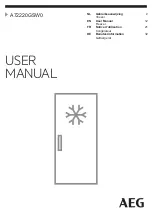
en
40
Freezer compartment
Use the freezer compartment
■
To store deep-frozen food.
■
To make ice cubes.
■
To freeze food.
Note
Ensure that the freezer compartment
door has been closed properly. If
the door is open, the frozen food will
thaw. The freezer compartment will
become covered in thick ice. Also: waste
of energy due to high power
consumption!
Freezing capacity
Information on the freezing capacity can
be found on the rating plate. Fig.
/
Freezing and storing
food
Purchasing frozen food
■
Packaging must not be damaged.
■
Use by the ”use by” date.
■
Temperature in the supermarket
freezer must be -18 °C or lower.
■
If possible, transport deep-frozen food
in a cool bag and place quickly in
the freezer compartment.
Freezing fresh food
Freeze fresh and undamaged food only.
To retain the best possible nutritional
value, flavour and colour, vegetables
should be blanched before freezing.
Aubergines, peppers, zucchini and
asparagus do not require blanching.
Literature on freezing and blanching
can be found in bookshops.
Note
Keep food which is to be frozen away
from food which is already frozen.
■
The following foods are suitable for
freezing:
Cakes and pastries, fish and seafood,
meat, game, poultry, vegetables, fruit,
herbs, eggs without shells, dairy
products such as cheese, butter and
quark, ready meals and leftovers such
as soups, stews, cooked meat and
fish, potato dishes, soufflés and
desserts.
■
The following foods are not suitable
for freezing:
Types of vegetables, which are usually
consumed raw, such as lettuce or
radishes, eggs in shells, grapes,
whole apples, pears and peaches,
hard-boiled eggs, yoghurt, soured
milk, sour cream, crème fraîche and
mayonnaise.
Summary of Contents for KDD Series
Page 132: ... ...
Page 133: ... ...
Page 134: ... 1 3 2 4 5 1 2 3 5 4 ...
















































